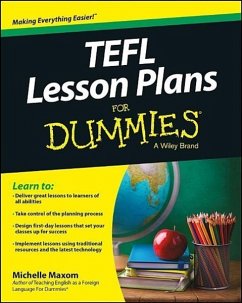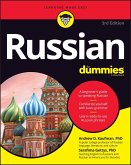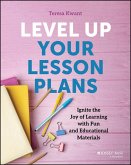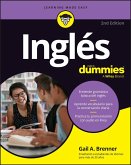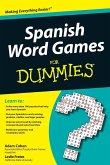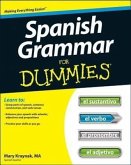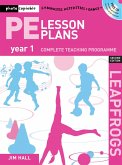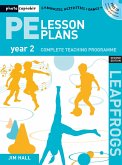Michelle M. Maxom
TEFL Lesson Plans For Dummies
Michelle M. Maxom
TEFL Lesson Plans For Dummies
- Broschiertes Buch
- Merkliste
- Auf die Merkliste
- Bewerten Bewerten
- Teilen
- Produkt teilen
- Produkterinnerung
- Produkterinnerung
Instant English lessons learn in a flash! TEFL Lesson Plans For Dummies is a ready-made course manual for TEFL teachers. With fully fleshed-out lessons, activities, tools, games, and resources, this book contains what is essentially an instant TEFL course.
Andere Kunden interessierten sich auch für
![Russian For Dummies Russian For Dummies]() Andrew D. Kaufman (University of Georgia)Russian For Dummies16,99 €
Andrew D. Kaufman (University of Georgia)Russian For Dummies16,99 €![Level Up Your Lesson Plans Level Up Your Lesson Plans]() Teresa K. KwantLevel Up Your Lesson Plans29,99 €
Teresa K. KwantLevel Up Your Lesson Plans29,99 €![Inglés Para Dummies Inglés Para Dummies]() Gail BrennerInglés Para Dummies25,99 €
Gail BrennerInglés Para Dummies25,99 €![Spanish Word Games for Dummies Spanish Word Games for Dummies]() Adam CohenSpanish Word Games for Dummies19,99 €
Adam CohenSpanish Word Games for Dummies19,99 €![Spanish Grammar for Dummies Spanish Grammar for Dummies]() Cecie KraynakSpanish Grammar for Dummies25,99 €
Cecie KraynakSpanish Grammar for Dummies25,99 €![PE Lesson Plans Year 1 PE Lesson Plans Year 1]() Jim HallPE Lesson Plans Year 133,99 €
Jim HallPE Lesson Plans Year 133,99 €![PE Lesson Plans Year 2 PE Lesson Plans Year 2]() Jim HallPE Lesson Plans Year 233,99 €
Jim HallPE Lesson Plans Year 233,99 €-
-
-
Instant English lessons learn in a flash! TEFL Lesson Plans For Dummies is a ready-made course manual for TEFL teachers. With fully fleshed-out lessons, activities, tools, games, and resources, this book contains what is essentially an instant TEFL course.
Produktdetails
- Produktdetails
- For Dummies
- Verlag: John Wiley & Sons Inc
- Seitenzahl: 354
- Erscheinungstermin: 22. August 2014
- Englisch
- Abmessung: 233mm x 187mm x 22mm
- Gewicht: 672g
- ISBN-13: 9781118764275
- ISBN-10: 1118764277
- Artikelnr.: 39872711
- Herstellerkennzeichnung
- Libri GmbH
- Europaallee 1
- 36244 Bad Hersfeld
- gpsr@libri.de
- For Dummies
- Verlag: John Wiley & Sons Inc
- Seitenzahl: 354
- Erscheinungstermin: 22. August 2014
- Englisch
- Abmessung: 233mm x 187mm x 22mm
- Gewicht: 672g
- ISBN-13: 9781118764275
- ISBN-10: 1118764277
- Artikelnr.: 39872711
- Herstellerkennzeichnung
- Libri GmbH
- Europaallee 1
- 36244 Bad Hersfeld
- gpsr@libri.de
Michelle Maxom has taught both EFL students and would-be teachers for more than 15 years in the UK and Italy. She has served as Director of Studies at a central London EFL school, and as a freelance teacher/trainer Michelle has taught trainee TEFL teachers and courses and tutored distance learners.
Introduction 1
Part I: Methodology in the Madness 7
Chapter 1: Grasping The Basics Of TEFL Teaching 9
Chapter 2: Adapting Recent Approaches and Methodologies to Your Work 19
Chapter 3: Getting Down to Planning 45
Part II: Beginner and Elementary Classes 63
Chapter 4: Getting to Know Each Other on the First Day 65
Chapter 5: Back to Basics: Using Your Own Realia 77
Chapter 6: Getting Flash with Flashcards 87
Chapter 7: Making Use of Mobile Phones 95
Chapter 8: Covering Clothes and Fashion 105
Chapter 9: Acting It Out: Using Role-Plays 113
Part III: Pre-Intermediate and Intermediate Classes 121
Chapter 10: Cultivating Classroom Language from Day One 123
Chapter 11: Back to Basics: Developing Discussions 133
Chapter 12: Thinking Outside the Book 143
Chapter 13: Watching TV Online 151
Chapter 14: Culture: Extracting Language from Art 161
Chapter 15: Communicating through Story-telling 171
Part IV: Upper Intermediate and Advanced Classes 181
Chapter 16: First Day: Improving Intonation 183
Chapter 17: Back to Basics: Teaching Varieties of English 193
Chapter 18: Traditional Resources: Delving Into Dictionaries 203
Chapter 19: Technology: Interactive Websites 213
Chapter 20: Read All About It! Focusing on the News 223
Chapter 21: Dissecting Dictogloss 233
Part V: Mixed Classes 241
Chapter 22: Chatting to Children 243
Chapter 23: Training Teens 253
Chapter 24: Making Use of Readers 263
Chapter 25: Developing Presentation Skills 273
Chapter 26: Focusing on Manners and Etiquette 283
Chapter 27: Team Work: Going on Field Trips 293
Part VI: The Part of Tens 303
Chapter 28: Ten Ways to Improve Your Teaching Skills 305
Chapter 29: Ten Ways to Make Your Students Happy 311
Index 317
Part I: Methodology in the Madness 7
Chapter 1: Grasping The Basics Of TEFL Teaching 9
Chapter 2: Adapting Recent Approaches and Methodologies to Your Work 19
Chapter 3: Getting Down to Planning 45
Part II: Beginner and Elementary Classes 63
Chapter 4: Getting to Know Each Other on the First Day 65
Chapter 5: Back to Basics: Using Your Own Realia 77
Chapter 6: Getting Flash with Flashcards 87
Chapter 7: Making Use of Mobile Phones 95
Chapter 8: Covering Clothes and Fashion 105
Chapter 9: Acting It Out: Using Role-Plays 113
Part III: Pre-Intermediate and Intermediate Classes 121
Chapter 10: Cultivating Classroom Language from Day One 123
Chapter 11: Back to Basics: Developing Discussions 133
Chapter 12: Thinking Outside the Book 143
Chapter 13: Watching TV Online 151
Chapter 14: Culture: Extracting Language from Art 161
Chapter 15: Communicating through Story-telling 171
Part IV: Upper Intermediate and Advanced Classes 181
Chapter 16: First Day: Improving Intonation 183
Chapter 17: Back to Basics: Teaching Varieties of English 193
Chapter 18: Traditional Resources: Delving Into Dictionaries 203
Chapter 19: Technology: Interactive Websites 213
Chapter 20: Read All About It! Focusing on the News 223
Chapter 21: Dissecting Dictogloss 233
Part V: Mixed Classes 241
Chapter 22: Chatting to Children 243
Chapter 23: Training Teens 253
Chapter 24: Making Use of Readers 263
Chapter 25: Developing Presentation Skills 273
Chapter 26: Focusing on Manners and Etiquette 283
Chapter 27: Team Work: Going on Field Trips 293
Part VI: The Part of Tens 303
Chapter 28: Ten Ways to Improve Your Teaching Skills 305
Chapter 29: Ten Ways to Make Your Students Happy 311
Index 317
Introduction 1
Part I: Methodology in the Madness 7
Chapter 1: Grasping The Basics Of TEFL Teaching 9
Chapter 2: Adapting Recent Approaches and Methodologies to Your Work 19
Chapter 3: Getting Down to Planning 45
Part II: Beginner and Elementary Classes 63
Chapter 4: Getting to Know Each Other on the First Day 65
Chapter 5: Back to Basics: Using Your Own Realia 77
Chapter 6: Getting Flash with Flashcards 87
Chapter 7: Making Use of Mobile Phones 95
Chapter 8: Covering Clothes and Fashion 105
Chapter 9: Acting It Out: Using Role-Plays 113
Part III: Pre-Intermediate and Intermediate Classes 121
Chapter 10: Cultivating Classroom Language from Day One 123
Chapter 11: Back to Basics: Developing Discussions 133
Chapter 12: Thinking Outside the Book 143
Chapter 13: Watching TV Online 151
Chapter 14: Culture: Extracting Language from Art 161
Chapter 15: Communicating through Story-telling 171
Part IV: Upper Intermediate and Advanced Classes 181
Chapter 16: First Day: Improving Intonation 183
Chapter 17: Back to Basics: Teaching Varieties of English 193
Chapter 18: Traditional Resources: Delving Into Dictionaries 203
Chapter 19: Technology: Interactive Websites 213
Chapter 20: Read All About It! Focusing on the News 223
Chapter 21: Dissecting Dictogloss 233
Part V: Mixed Classes 241
Chapter 22: Chatting to Children 243
Chapter 23: Training Teens 253
Chapter 24: Making Use of Readers 263
Chapter 25: Developing Presentation Skills 273
Chapter 26: Focusing on Manners and Etiquette 283
Chapter 27: Team Work: Going on Field Trips 293
Part VI: The Part of Tens 303
Chapter 28: Ten Ways to Improve Your Teaching Skills 305
Chapter 29: Ten Ways to Make Your Students Happy 311
Index 317
Part I: Methodology in the Madness 7
Chapter 1: Grasping The Basics Of TEFL Teaching 9
Chapter 2: Adapting Recent Approaches and Methodologies to Your Work 19
Chapter 3: Getting Down to Planning 45
Part II: Beginner and Elementary Classes 63
Chapter 4: Getting to Know Each Other on the First Day 65
Chapter 5: Back to Basics: Using Your Own Realia 77
Chapter 6: Getting Flash with Flashcards 87
Chapter 7: Making Use of Mobile Phones 95
Chapter 8: Covering Clothes and Fashion 105
Chapter 9: Acting It Out: Using Role-Plays 113
Part III: Pre-Intermediate and Intermediate Classes 121
Chapter 10: Cultivating Classroom Language from Day One 123
Chapter 11: Back to Basics: Developing Discussions 133
Chapter 12: Thinking Outside the Book 143
Chapter 13: Watching TV Online 151
Chapter 14: Culture: Extracting Language from Art 161
Chapter 15: Communicating through Story-telling 171
Part IV: Upper Intermediate and Advanced Classes 181
Chapter 16: First Day: Improving Intonation 183
Chapter 17: Back to Basics: Teaching Varieties of English 193
Chapter 18: Traditional Resources: Delving Into Dictionaries 203
Chapter 19: Technology: Interactive Websites 213
Chapter 20: Read All About It! Focusing on the News 223
Chapter 21: Dissecting Dictogloss 233
Part V: Mixed Classes 241
Chapter 22: Chatting to Children 243
Chapter 23: Training Teens 253
Chapter 24: Making Use of Readers 263
Chapter 25: Developing Presentation Skills 273
Chapter 26: Focusing on Manners and Etiquette 283
Chapter 27: Team Work: Going on Field Trips 293
Part VI: The Part of Tens 303
Chapter 28: Ten Ways to Improve Your Teaching Skills 305
Chapter 29: Ten Ways to Make Your Students Happy 311
Index 317

